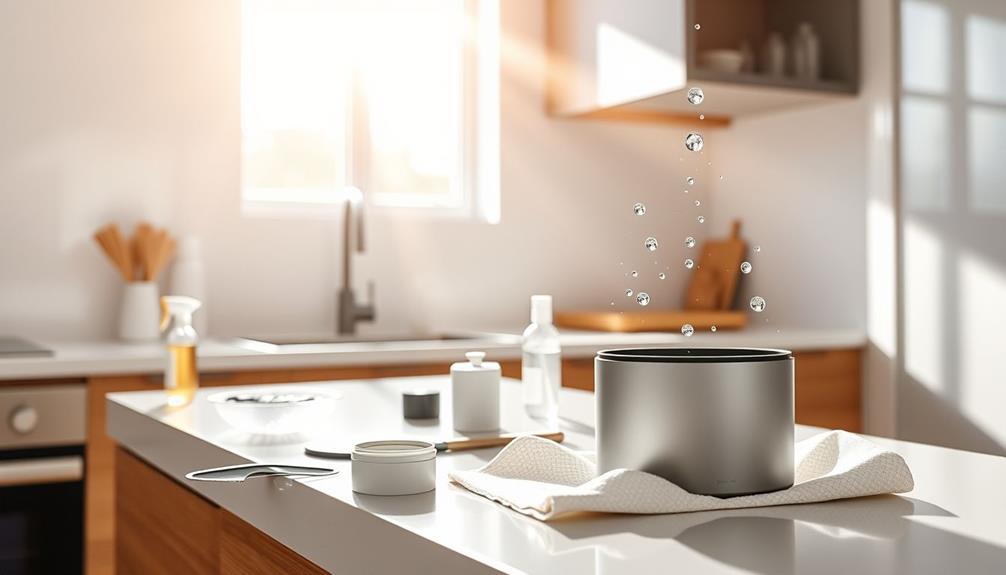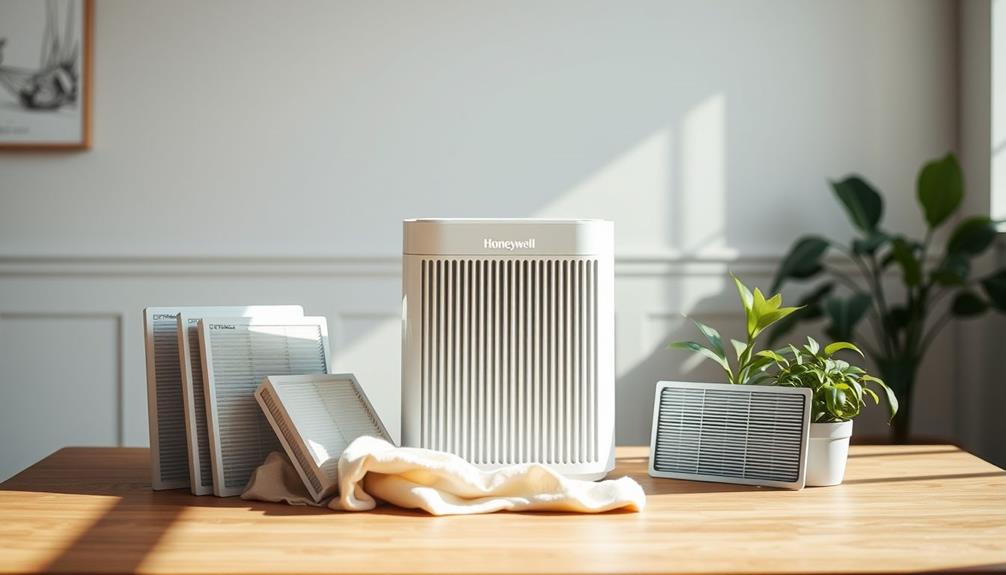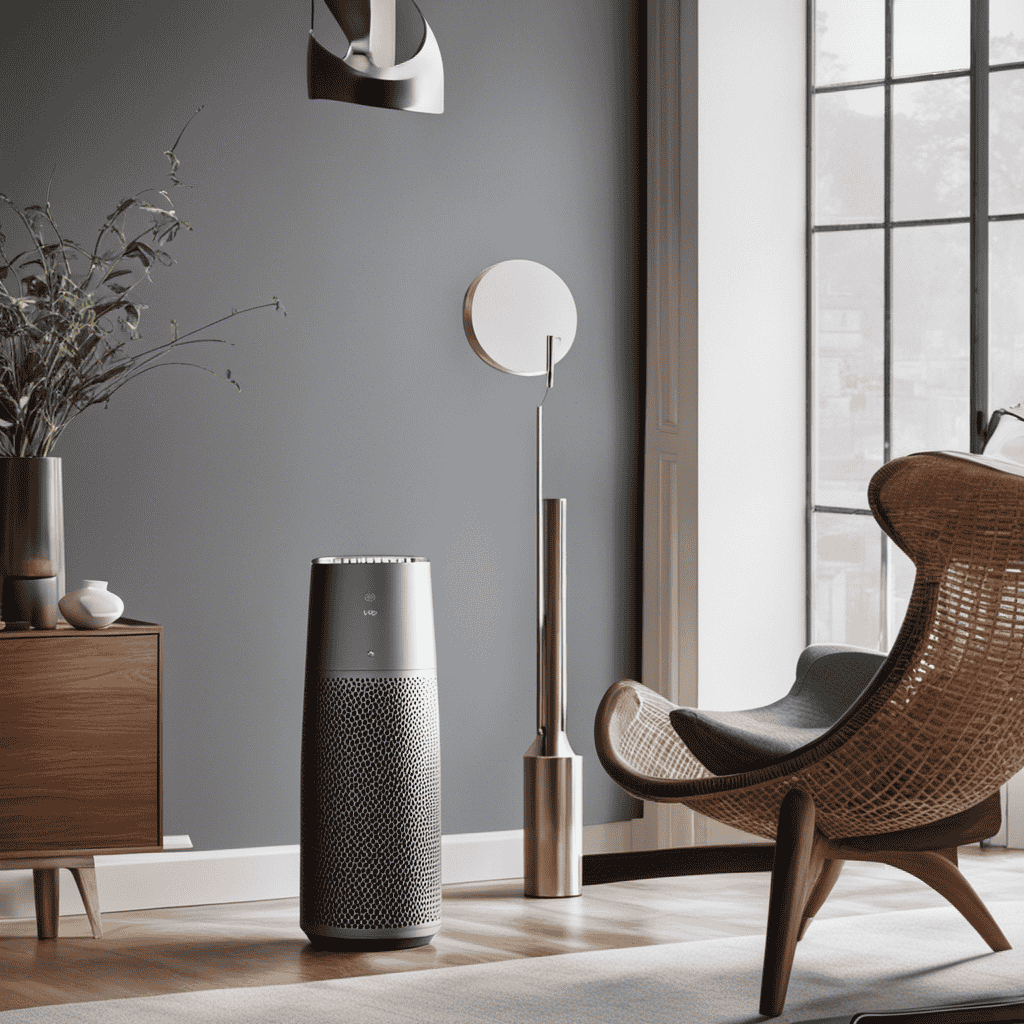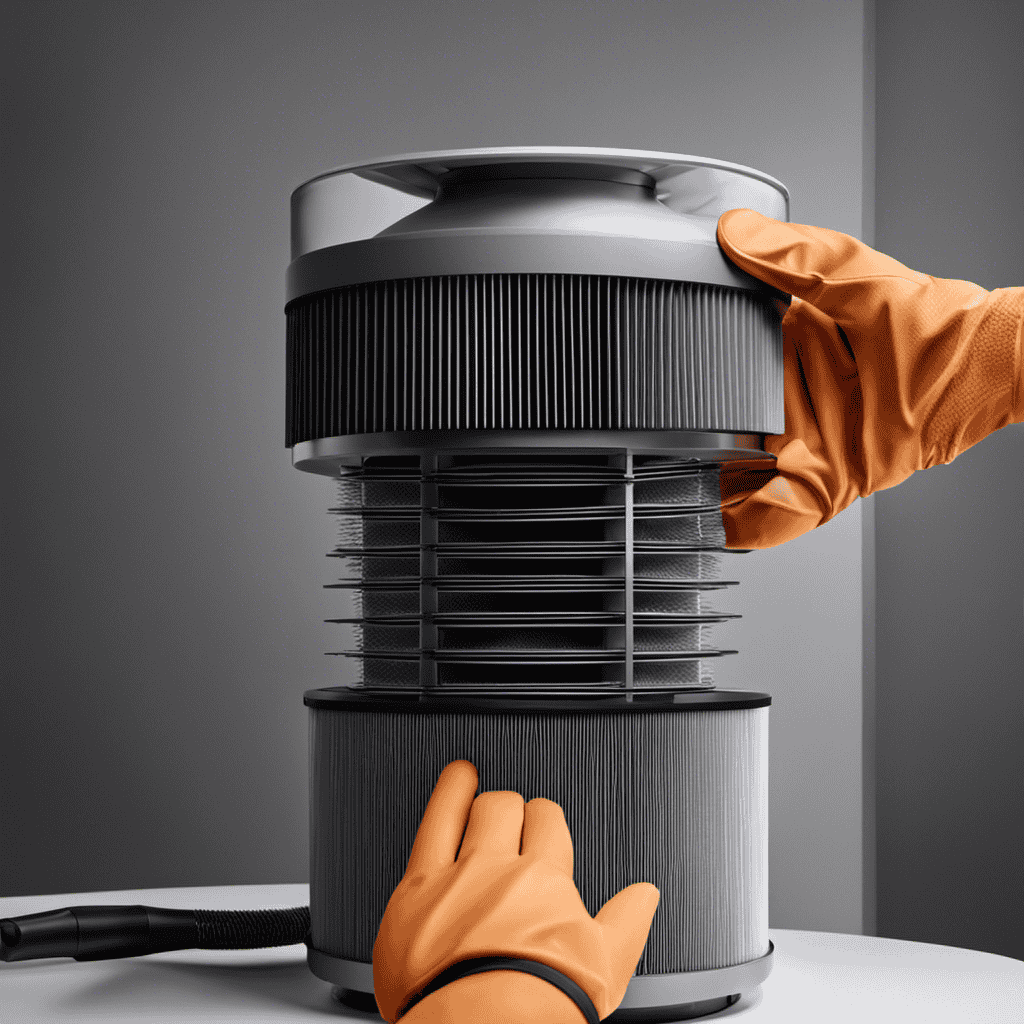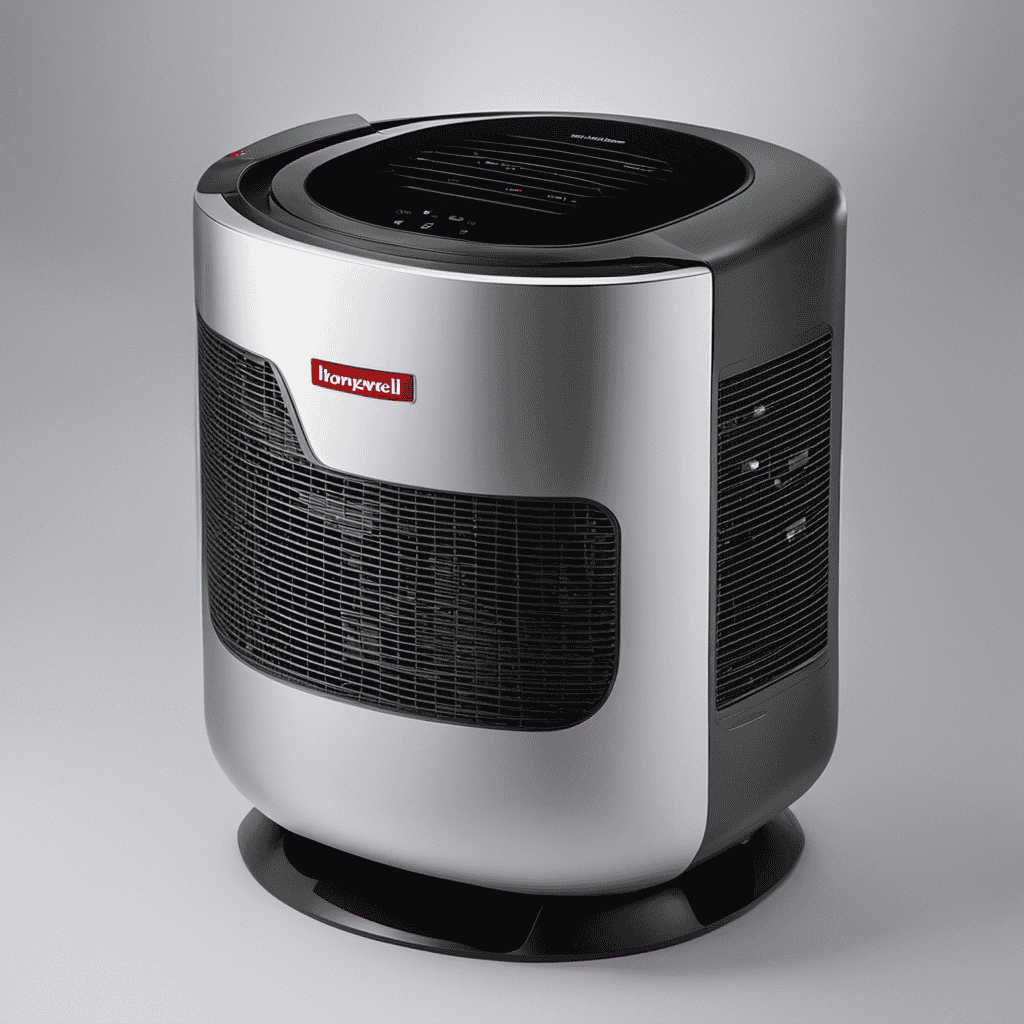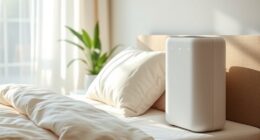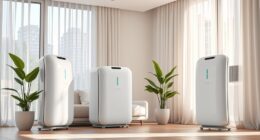To clean your Xiaomi air purifier, start by powering it off and unplugging it for safety. Remove the filter cover, take out the filters, and use a vacuum cleaner with a soft brush to gently clean them. Check the air quality sensor with a hairdryer on low, then wipe the exterior with a damp cloth. Make sure everything is dry before reassembling the unit. Remember to monitor the filter indicators and replace them as needed. This step-by-step guide guarantees your purifier runs efficiently, creating a healthier home environment. Keeping up with maintenance will certainly enhance your experience.
Key Takeaways
- Power off and unplug the air purifier before starting the cleaning process for safety.
- Replace HEPA filters every 6-12 months and clean pre-filters monthly to maintain efficiency.
- Use a vacuum cleaner with a soft brush to gently clean filters and a hairdryer for the air quality sensor.
- Wipe exterior surfaces weekly with a damp cloth, avoiding harsh chemicals to prevent damage.
- Regularly monitor filter indicators and air quality readings to ensure optimal performance and timely maintenance.
Importance of Regular Maintenance
When it comes to your Xiaomi air purifier, staying on top of regular maintenance is vital to keeping it running smoothly. By performing routine upkeep, you enhance its air purification efficiency, guaranteeing clean indoor air quality. This creates a healthier living environment for you and your loved ones.
Regular maintenance tasks, including filter replacement and proper cleaning techniques, help minimize the accumulation of dust and pollutants, which can harm your respiratory health. Additionally, using air purifiers is important for improving overall well-being, as air purifiers reduce allergens and harmful particles in indoor environments.
Maintaining your air purifier is essential for prolonging its lifespan. When you keep the device in ideal working condition, you prevent the need for costly repairs or replacements down the line.
Consistent upkeep also guarantees compliance with warranty requirements, protecting your investment.
Filter Replacement Guidelines
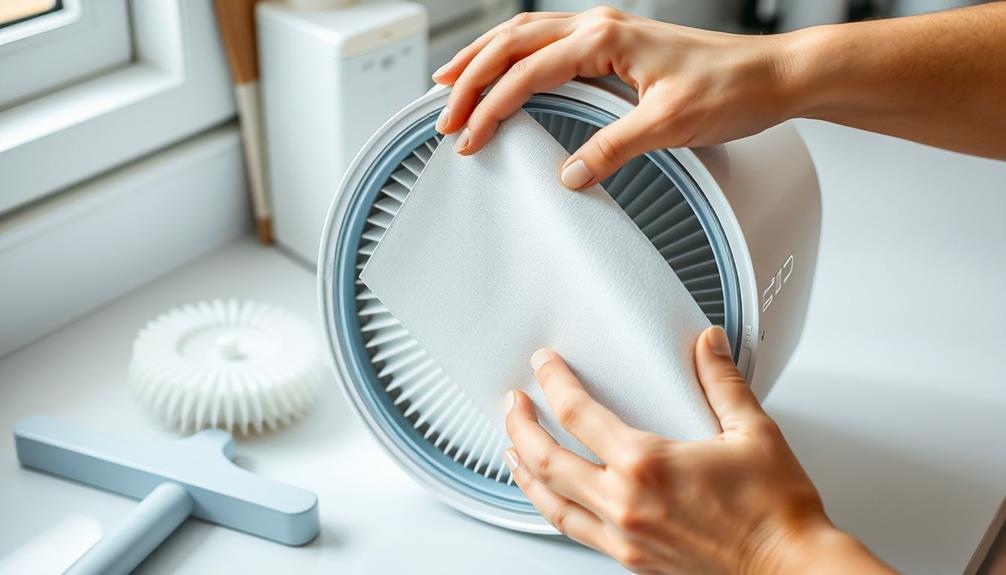
To keep your Xiaomi Air Purifier running efficiently, you need to replace its filters regularly.
Regular filter changes are essential for maintaining efficiency and guaranteeing your air remains clean and fresh. Pay attention to the filter indicator lights, as they'll let you know when it's time for a change.
Always use genuine Xiaomi filters to guarantee compatibility and peak performance.
Additionally, following proper maintenance guidelines can enhance the longevity of your purifier and improve its effectiveness in reducing allergens and harmful particles in your indoor environment, as noted in the importance of air purifiers.
Replacement Frequency Recommendations
Regular maintenance of your Xiaomi air purifier is essential for its performance, and knowing when to replace the filters is key. Following these replacement frequency recommendations will help you maintain ideal air purification:
Additionally, keeping your home free from toxic substances, like chocolate which poses risks to dogs, can enhance overall air quality, benefiting both pets and humans. For more information on household dangers, refer to ten household dangers identified for dogs.
- HEPA filters: Replace every 6-12 months to guarantee effective filtration of airborne particles.
- Activated carbon filters: Change every 3-6 months, depending on your usage and local air quality.
- Pre-filters: Clean monthly to prevent dust accumulation and improve overall efficiency.
- Filter indicator lights: Keep an eye on these reminders to know when it's time for a replacement.
- Genuine Xiaomi filters: Always use these to comply with warranty requirements and achieve the best results.
Genuine Filter Usage
Using genuine filters in your Xiaomi air purifier is vital for maintaining its efficiency and guaranteeing clean air in your home. To achieve peak performance, always adhere to the manufacturer's guidelines regarding filter replacement.
For instance, HEPA filters should be replaced every 6-12 months, while activated carbon filters need changing every 3-6 months, depending on your air quality and usage. Additionally, just as a vacuum like the Bissell Pet Hair Eraser benefits from a self-cleaning brush roll to enhance performance, maintaining your air purifier with genuine filters guarantees it operates effectively.
To keep your Xiaomi running smoothly, don't forget to clean the pre-filters monthly to prevent dust buildup and maintain proper airflow. Regular maintenance of your Xiaomi air purifier not only enhances its efficiency but also improves the overall air quality in your living space.
Using third-party filters might seem cost-effective, but they often don't fit properly and can hinder your purifier's performance. Stick with genuine filters to guarantee your device operates as intended and complies with warranty requirements.
Monitoring Filter Indicators
Monitoring filter indicators on your Xiaomi air purifier is vital for maintaining ideal air quality and performance. By keeping an eye on these indicators, you can guarantee timely filter replacement and peak functionality.
Implementing a holistic lifestyle approach can further enhance your indoor air quality, contributing to overall well-being. Here are some key points to evaluate:
- Replace HEPA filters every 6-12 months.
- Change activated carbon filters every 3-6 months, depending on usage.
- Clean pre-filters monthly to extend their lifespan.
- Refer to your user manual for specific filter replacement guidelines.
- Always use genuine Xiaomi filters for the best results.
Regularly checking the filter indicators helps you stay on top of maintenance procedures. If the indicator light turns on, it's time to assess the filters.
For HEPA filters, remember that their efficiency diminishes over time, so timely replacement is essential for effective air purification. Pre-filters capture larger particles, and cleaning them monthly will enhance their performance while prolonging the life of your HEPA filter.
Always consult your user manual for tailored advice regarding your specific Xiaomi air purifier model and adhere to these guidelines to keep your indoor air quality at its best.
Cleaning and Care Tips
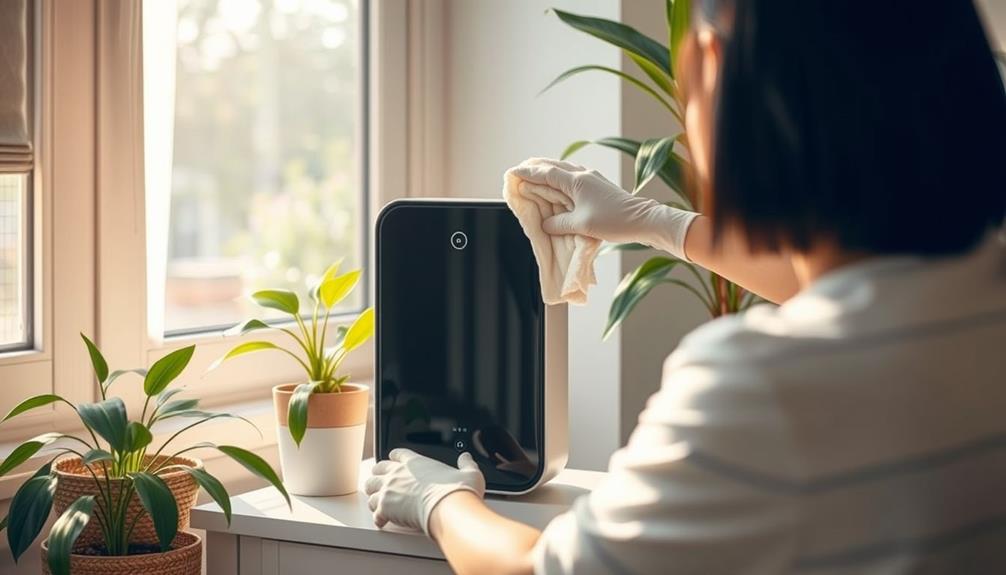
Keeping your Xiaomi air purifier in top shape requires some simple care routines. Start with regular cleaning to prevent dust buildup. Wipe the exterior surfaces weekly with a damp cloth to keep it looking good and functioning well.
Don't forget to clean the air inlet and outlet grilles regularly; this helps guarantee optimal airflow and enhances the device's efficiency. Additionally, it's beneficial to be mindful of the environment around your air purifier, as certain smells and pollutants can affect its performance, much like how cats can be sensitive to air quality.
When you clean the Xiaomi air purifier, always power off the unit first. This step is essential for your safety and prevents any accidental damage to internal components.
During cleaning, avoid using harsh chemicals or abrasive materials, as these can damage the unit and affect its performance. Instead, stick to gentle cleaning solutions.
To further improve your air purifier's longevity, try to keep it in a dust-free environment. This simple habit minimizes the need for frequent cleaning and helps maintain clean and fresh air in your home.
Troubleshooting Common Issues
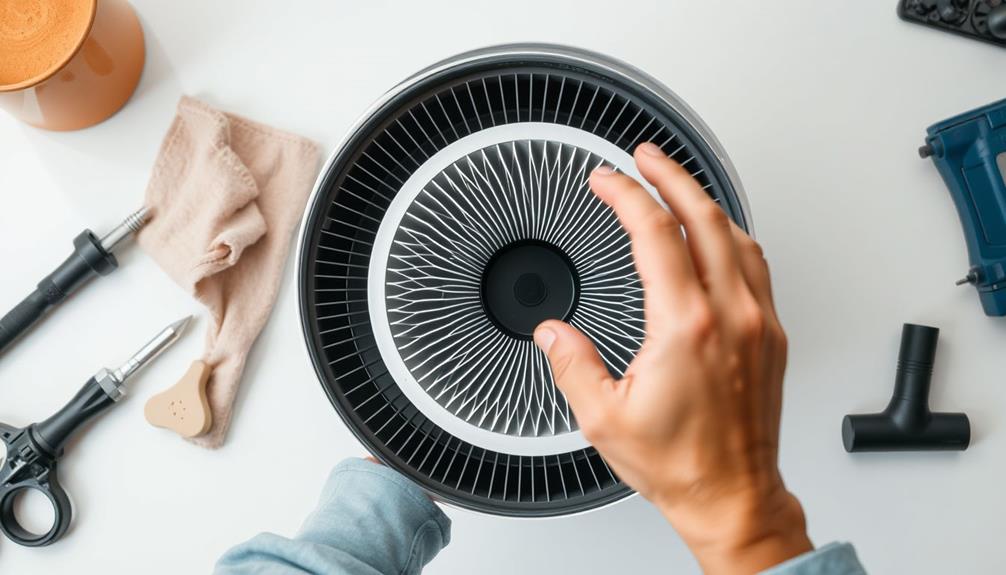
Even with regular cleaning and care, you might encounter some common issues with your Xiaomi air purifier. Here are a few things to keep in mind:
- Check for error codes on the display, as these can indicate specific issues that need addressing. For example, understanding the key factors in choosing a home cleaning service can help in selecting a professional service to maintain your home's air quality effectively.
- Confirm the device is plugged in and powered on.
- Inspect the filters for proper installation.
- Reset the device if it becomes unresponsive.
- Regularly clean the air quality sensor.
If your purifier displays error codes, consult the user manual for specific troubleshooting steps. Sometimes, the issue could be as simple as it being unplugged or turned off.
To confirm proper operation, regularly clean and inspect the filters, as clogged or incorrectly placed filters can lead to performance issues. If you notice that your device isn't functioning, try resetting it by unplugging it for a few minutes before plugging it back in.
Dust accumulation can also affect the sensor's readings, so it's essential to regularly clean the air quality sensor.
Preparing for Cleaning
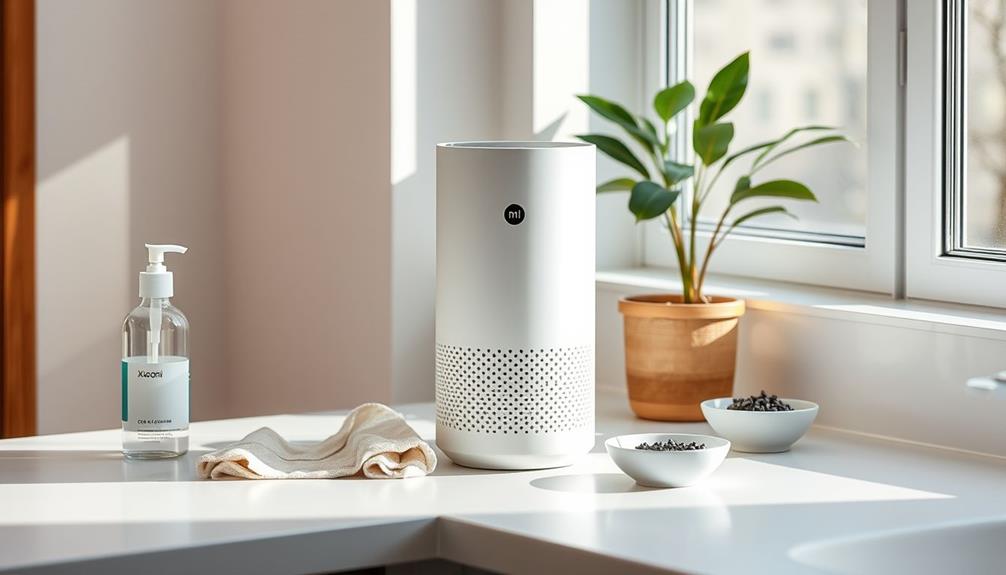
Before you start cleaning your Xiaomi air purifier, make sure it's powered off and unplugged to avoid any electrical hazards.
It's also wise to check for energy-efficient appliances that can help reduce costs while providing better air quality.
Next, gather your essential cleaning tools like a soft cloth, small brush, and mild detergent to make the process smoother.
Safety Precautions First
Cleaning your Xiaomi air purifier requires some important safety precautions to guarantee a smooth process. Following these steps will help protect you from potential hazards while ensuring an effective cleaning experience.
It's also beneficial to incorporate relaxation techniques, such as deep breathing, to maintain a calm mindset while cleaning the device and to enhance your overall well-being yoga for relaxation.
- Always unplug the device before starting.
- Allow the purifier to cool down for a few minutes after use.
- Set up your cleaning area in a well-ventilated space.
- Wear gloves and a mask if you're sensitive to dust or allergens.
- Organize all necessary cleaning tools beforehand.
First and foremost, unplugging your air purifier is essential for safety. This prevents any electrical accidents during the cleaning process.
Give the unit a few minutes to cool down after use to avoid burns or injuries.
Next, find a well-ventilated area to minimize the inhalation of dust and allergens while you clean.
If you have allergies or sensitivities, don't skip wearing gloves and a mask to protect yourself from irritants.
Finally, gather your cleaning tools in advance to streamline the process, making sure you're fully prepared to tackle the task ahead.
Following these precautions will set you up for a successful cleaning experience.
Essential Cleaning Tools
What tools do you need to effectively clean your Xiaomi air purifier? Having the right essential cleaning tools at your fingertips makes the process smoother and more efficient. Here's a handy list to help you get started:
| Tool | Purpose |
|---|---|
| Soft Cloth | Gently wipe the exterior surfaces |
| Vacuum Cleaner Attachment | Remove dust and debris from filters |
| Mild Detergent | Clean washable filters without harsh chemicals |
| Hairdryer (Low Setting) | Gently clean air quality sensors |
Using a soft cloth for gentle cleaning helps avoid scratches while maintaining the purifier's appearance. For internal components, a small brush or vacuum cleaner attachment can effectively eliminate dust without causing damage. When it comes to cleaning washable filters, mix mild detergent with warm water to guarantee you don't harm any parts. Finally, a hairdryer set on low is perfect for keeping air quality sensors dust-free, enhancing the purifier's performance. By organizing all these tools beforehand, you'll create a seamless cleaning experience that keeps your air purifier functioning at its best.
Gathering Necessary Tools
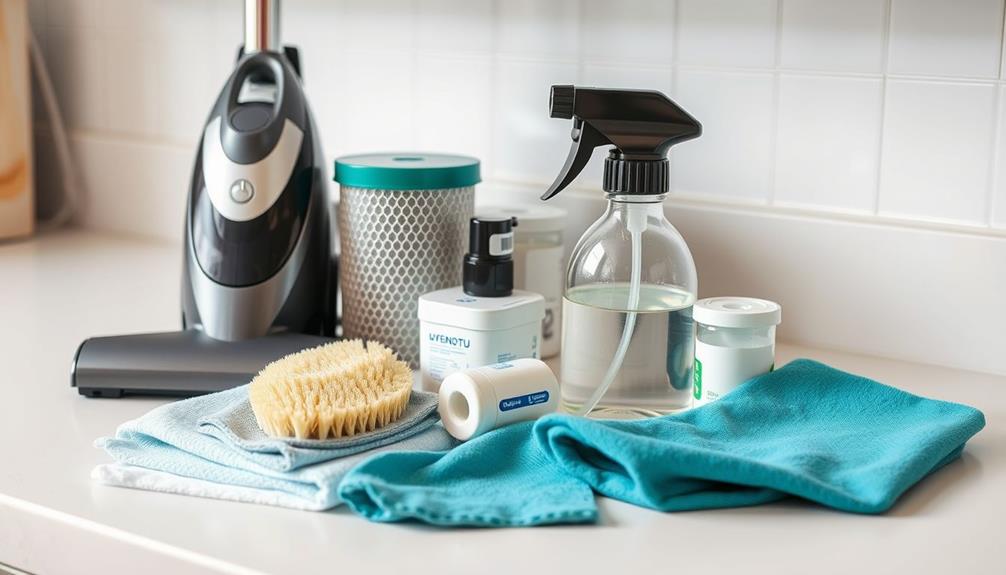
To guarantee a smooth cleaning process, you'll need to gather a few essential tools beforehand. First and foremost, make sure that your Xiaomi air purifier is unplugged for safety. This step is vital before you start gathering your necessary tools.
Organizing these tools in a well-ventilated area will make everything more accessible during the cleaning process. Additionally, it's important to regularly maintain your air purifier to guarantee peak performance, similar to how you'd care for well-draining soil for plants.
Here's a quick list of what you'll need:
- Soft cloth: For wiping surfaces without scratching.
- Small brush: Ideal for dusting hard-to-reach areas.
- Vacuum cleaner: To remove loose particles effectively.
- Mild detergent: For cleaning washable filters without damage.
- Warm water: To mix with your mild detergent for a gentle cleaning solution.
Having these cleaning tools ready will help you tackle the task efficiently.
Step-by-Step Cleaning Process
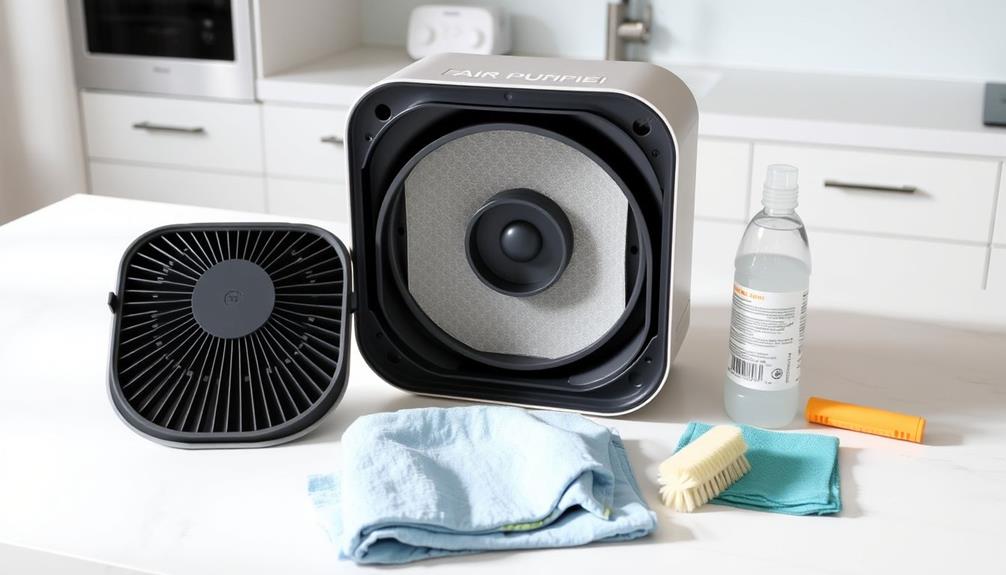
A thorough cleaning process for your Xiaomi air purifier can greatly enhance its performance and longevity, much like the key components for a healthy lifestyle that contribute to overall well-being.
Start by powering off and unplugging the device for safety. Next, remove the filter cover and gently extract the air purifier's filter, being cautious not to damage it.
Use a vacuum cleaner with a soft brush attachment to remove dust from the filters and inner components. This step is essential for peak performance. For the air quality sensor, use a hair dryer on a low setting to clean it carefully.
Then, wipe down the exterior surfaces with a damp cloth, avoiding harsh chemicals and abrasive materials that could cause damage. This helps maintain the unit's appearance while ensuring it effectively cleans the air.
After cleaning, allow the filters to dry properly before reinserting them. Secure the filter cover back in place, then plug the device back in to resume normal operation.
Following these steps regularly will keep your air purifier functioning at its best, ensuring a healthier environment.
Reassembly and Restart
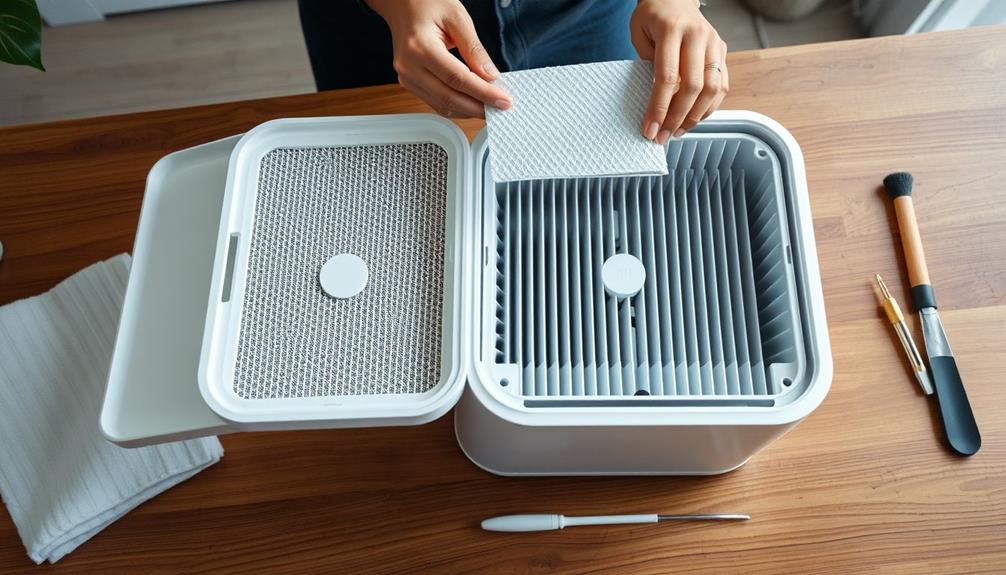
Reassembling your Xiaomi air purifier is vital for restoring its functionality after cleaning. Follow these steps to guarantee everything is put back together correctly:
- Reinstate the filter to maintain ideal airflow.
- Confirm the filter cover is properly aligned.
- Wait a few minutes before plugging it back in.
- Monitor the air quality indicators after restarting.
- Verify the purifier is in normal functioning mode.
Start by reinserting the filter into its designated slot, making sure it fits securely. This step is fundamental for maintaining ideal airflow and efficiency.
Next, properly align the filter cover with the unit. Press down firmly until you hear a click, confirming it's secured in place.
Allow your air purifier to sit for a few minutes after reassembly to confirm any remaining moisture evaporates.
Once that's done, plug it back in and press the power button to turn it on. Pay attention to the operational lights—they should indicate normal functioning.
Testing the Purifier
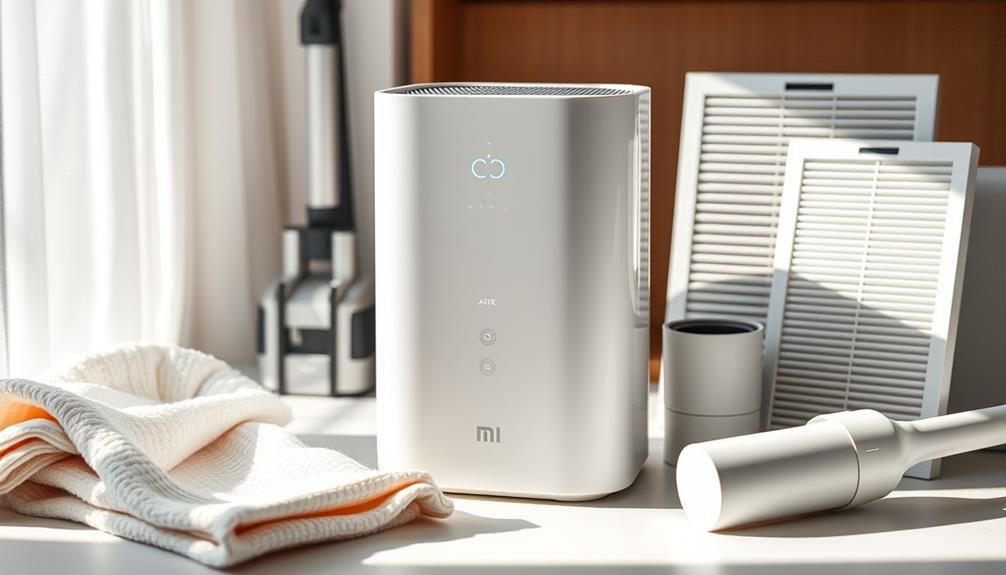
After you've cleaned your Xiaomi air purifier, make sure it's plugged into a working outlet to confirm it's getting power.
Next, adjust the fan settings to see if it responds properly at different speeds.
Check Power Connection
To guarantee your Xiaomi air purifier is operational, start by checking the power connection. Ensuring your device is plugged into a functioning electrical outlet is essential for a steady power supply.
Here are some steps to help you confirm it's ready to go:
- Inspect the power cord for any visible damages or frays.
- Make sure the plug is securely inserted into the electrical outlet.
- Check that the power button is in the "on" position.
- Listen for any operational sounds, like the fan noise, indicating your purifier is receiving power and functioning correctly.
If it doesn't power on, try resetting it by unplugging it for a few minutes, then plug it back in and turn it on again.
Adjust Fan Settings
Once you've confirmed your Xiaomi air purifier is powered on and ready, it's time to adjust the fan settings. You can use the control panel or the mobile app to select different fan speeds, typically ranging from low to high. This will help you test the functionality and guarantee peak performance.
As you adjust the fan settings, keep an eye on the air quality indicators displayed on the panel. This will allow you to monitor how effectively the purifier responds to the changes in fan speed:
| Fan Speed | Effect on Air Quality |
|---|---|
| Low | Minimal airflow |
| Medium | Balanced performance |
| High | Maximum purification |
Regularly testing the fan speeds not only guarantees you're getting the best air quality but also helps identify any operational issues that might require maintenance. By adjusting the fan settings based on real-time air quality readings, you can enhance your clean Xiaomi Air Purifier's functionality, keeping your environment fresh and healthy.
Monitor Air Quality
As you monitor the air quality indicators on your Xiaomi air purifier, you'll gain valuable insights into its performance and effectiveness in eliminating indoor pollutants.
Regularly checking these indicators helps you maintain a healthy indoor environment. Here are some key points to take into account:
- Utilize built-in sensors for real-time feedback on air quality levels.
- Check the app or display for error codes indicating filter replacement needs.
- Conduct performance tests after cleaning or replacing filters to guarantee efficiency.
- Track air quality fluctuations throughout the day, noting how external factors impact it.
- Adjust purifier settings based on air quality readings for ideal air purification.
Tips for Optimal Performance
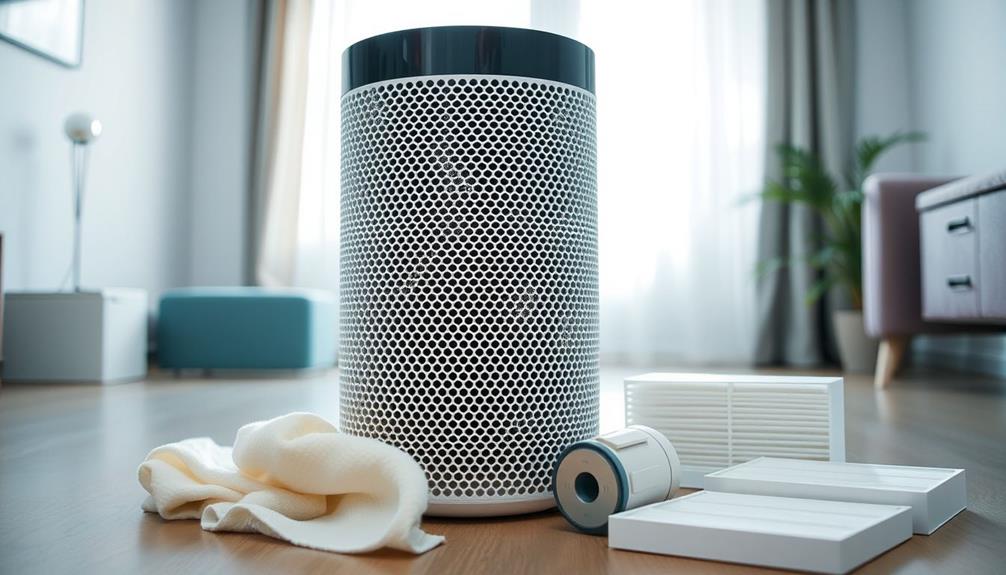
Maximizing the performance of your Xiaomi air purifier requires a proactive approach to maintenance and usage.
Start by regularly monitoring the Air Purifier Filter; replace the HEPA filters every 6-12 months. This guarantees peak performance and reduces allergens in your home.
Don't forget to clean pre-filters monthly by washing them with water. This helps maintain airflow and prevents accumulated dust, which can hinder efficiency.
Make sure you're using genuine Xiaomi filters and components to align with the manufacturer's instructions. This not only assures compatibility but also boosts effectiveness.
For the best results, position your air purifier in the most utilized room, and keep windows and doors closed during operation. This creates an excellent environment for eliminating dust particles and improving air quality.
Additionally, keep the exterior of the purifier clean by wiping it down weekly with a damp cloth.
Steer clear of harsh chemicals that could damage the unit.
Conclusion
Maintaining your Xiaomi air purifier is essential for its performance and longevity. By following the steps outlined, you'll guarantee cleaner air and a healthier environment. For instance, imagine a family in a city plagued by pollution; after regularly cleaning their purifier and replacing the filters, they noticed a significant drop in allergy symptoms. With just a little effort, you can achieve similar results, breathing easier and enjoying fresher air in your home.
